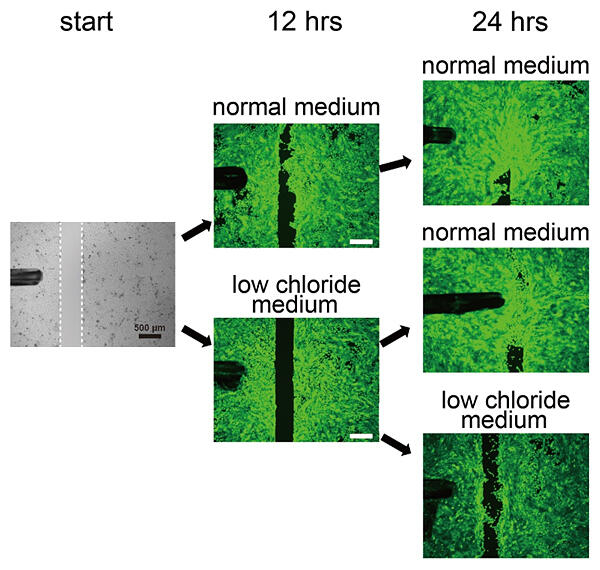A research group led by Professor Makoto Tominaga of the Exploratory Research Center on Life and Living Systems, National Institutes of Natural Sciences, in collaboration with Dr. Yu Yamanoi of pharmaceutical manufacturer Ikeda Mohando Co., Ltd., lecturer Yasunori Takayama of the School of Medicine, Showa University, Associate Professor Shigekuni Hosogi of Kyoto Pharmaceutical University, and Chair Professor Yoshinori Marunaka of Ritsumeikan University, has discovered a new mechanism involved in healing wounds.

Cultured epidermal cells were partially removed (within the white dotted line in the left‐hand photograph) and the process of epidermal cells filling this space was observed. In the absence of an inhibitor of the chloride ion channel ANO1, the space fills up over time, but with an inhibitor the space hardly fills up at all.
Provided by National Institute for Physiological Sciences
When skin wounds heal, it is important that epidermal cells proliferate and migrate to fill the wound. It has been known that TRPV3, one of the temperature sensitive TRP channels, is involved in such cellular activity, but how TRPV3 regulates cellular functions was not well understood.
The research group has found that TRPV3 activates calcium ions, which in turn activate ANO1, a chloride (chlorine) ion channel that causes epidermal cell proliferation and migration through the influx of chloride ions into the cell.
"The results of this study show that chloride ions play an important role in healing wounds, and we expect the enhancement of ANO1 functions to lead to the development of new wound treatment methods, as ANO1 works to repair wounds," noted Tominaga.
■ TRP channel (transient receptor potential‐type channel): A general term for non‐selective cation (positively charged ion) channel with homology to proteins originally encoded by TRP, the gene responsible for Drosophila visual mutants.
■ TRPV3: A temperature receptor that is activated at 32‐39℃ and has been reported to be expressed in sensory nerves, the brain and keratinocytes.
This article has been translated by JST with permission from The Science News Ltd. (https://sci-news.co.jp/). Unauthorized reproduction of the article and photographs is prohibited.




